Mikro-Mir DeHavilland Venom FB4
The Airplane:
De Havilland proposed a development of the Vampire for the high altitude fighter-bomber role in 1948, using a thinner wing and a more powerful engine. With the4 company identification of DH 112, further development to fulfill Air Ministry requirement OR.277, defined in Specification F.15/49, for a ast, maneuverable fighter -bomber to replace the Vampire in that role.
While generally similar in layout to the preceding Vampire, sharing the distinctive twin-boom tail and composite wood/metal structure, the Venom was a completely new design, powered by the de Havilland Ghost 103 jet engine with 4,850lb of thrust, 50% more powerful than the de Havilland Goblin used by the Vampire.
Both the Royal Air Force and the Royal Navy took interest in the Venom, with the version developed for the RN being a two-seat radar-equipped all-weather fighter, which was also adopted in a non-naval configuration by the RAF to replace the interim Vampire night fighter. The RAF, however, concentrated on the single-seat fighter bomber, the prototype of which first flew on September 2, 1949.
The Venom entered service with the RAF in 1952, in both the single-seat FB 1 fighter-bomber (365 constructed) and two-seat NF 2 night fighter (90 built), which was replaced in 1953 by the NF 3 (129 built). British Venoms saw active combat during their operational life, including the Suez Crisis, the Malayan Emergency, and the Aden Emergency. It was withdrawn from frontline operations by the RAF in 1962. From the beginning, the fighter-bomber was to be given to overseas forces, such as the Second Tactical Air Force in Germany as well as Cyprus, the Middle East, Africa, and Asia.
The Venom FB 4 first flew on December 29, 1953, and entered service in 1955; 250 were built, with an improved de Havilland Ghost 105 jet engine rated at 5150lb of thrust. The FB.4 was first Venom to be fitted with an ejection seat, as well as having redesigned tail surfaces and hydraulically-powered ailerons, and air conditioning for the cockpit.
The Venom was also proved popular on the export market, with the air forces of Iraq, New Zealand, Sweden, Switzerland and Venezuela using Venoms. The Swiss Air Force finally retired their last Venoms in 1983. Several of the Swiss Venoms have been acquired by private owners and several continue to fly, being seen in aerial displays at various air shows, while many have been preserved in static display conditions in museums and as gate guardians.
The Venom FB 4, which had equipped, 6, 8, and 249 squadrons at Akrotiri, Cyprus between March and July 1956, saw combat service during the Suez Crisis during late 1956. The Venoms attacked military installations on the ground; 6 Squadron, which had operated the FB 4 the longest, took the leading role. Only a single RAF Venom FB 4 was lost during the crisis.
The kit:
Classic Airframes released a Venom FB 1, FB 4, NF 2 and Sea Venom FAW 21/22 in 2003-04. These kits now go for over $100 at eBay, though I was able to get a Sea Venom from the Rare Plane Detective for $35 and would have gotten an FB 4 for the same price but I was ten minutes late making my phone call.
Mikro Mir released their FB 4 last fall. At a price of $55, it is considerably less expensive than a collector-kit Classic Airframes model. Unlike the Classic Airframes kit, all parts are plastic. The kit is based on a contemporary warbird ex-Swiss AF Venom, and as such uses the later, larger underwing tanks developed in Switzerland for their Venoms. Decals are provided for two units - 28 Squadron at Kai Tak in 1963 (I actually saw these airplanes during my first visit to Hong Kong in the Navy that year, just before they left service) and 11 Squadron in 2TAF at Wunsdorf, Germany in 1957.
Construction:
Mikro-Mir models are limited run kits, and not as high-end as Dor Wings or AMG kits; their parts fit can be problematic and you will always use filler on the kits.
The construction design of the central pod with the cockpit and engine is problematic. I spent quite a bit of time test-fitting parts before I concluded that the sequence in the instruction sheet was not going to cut it.
I ended up building the model by basing everything on the lower pod/wing part, and building up from there. I constructed the engine exhause and the intake trunking, and attached those to the lower airfame part. I then attached the upper airframe part, and found there was a need for C-A glue to get hold the assembly in position so that the interior parts fit to the exterior parts. I also assembled and attached the booms and the tail assembly
I then assembled the cockpit and attached it, then the outer nose parts around the cockpit, after stuffing squashed fishweights everywhere I could; with the airframe mostly assembled, I was able to confirm the model would nose sit. I also needed CA glue here to get the parts to align.
I then applied Mr. Surfacer to every assembly join and sanded smooth. The result looks good, but it took a lot of work to get there. With that, the model was assembled.
I didn't like the kit's ejection seat, and instead used a Quickboost resin Martin-Baker Mk.2 seat, which looks “close enough” to the Mk.1A seat the Venom used.
Painting:
I researched Venoms in Operation Musketeer and found some photos of 6 Squadron Venoms, which did not carry any unit insignia during the operation, which made the choice easy. I used Gunze Sangyo PRU Blue, Dark Sea Grey and (post war) RAF Dark Green for the camouflage. I painted and masked the yellow and black ID stripes first.
Markings:
I used the kit decals, which went down without problems under a coat of Solvaset.
Final Assembly:
I assembled and attached the landing gear, attached the underwing tanks, and posed the canopy in the open position. At that point I called it done.
Overall:
If you are a fan of British aircraft of the 1950s, you want a Venom in the collection. This kit by Mikro-Mir isn't as nice as the Airfix Vampire F.3, but with effort it is acceptable, and it's a lot cheaper and more available than the Classic Airframes Venom kits. Recommended for modelers with experience of doing limited run kits for which “some modeling skill is required.”
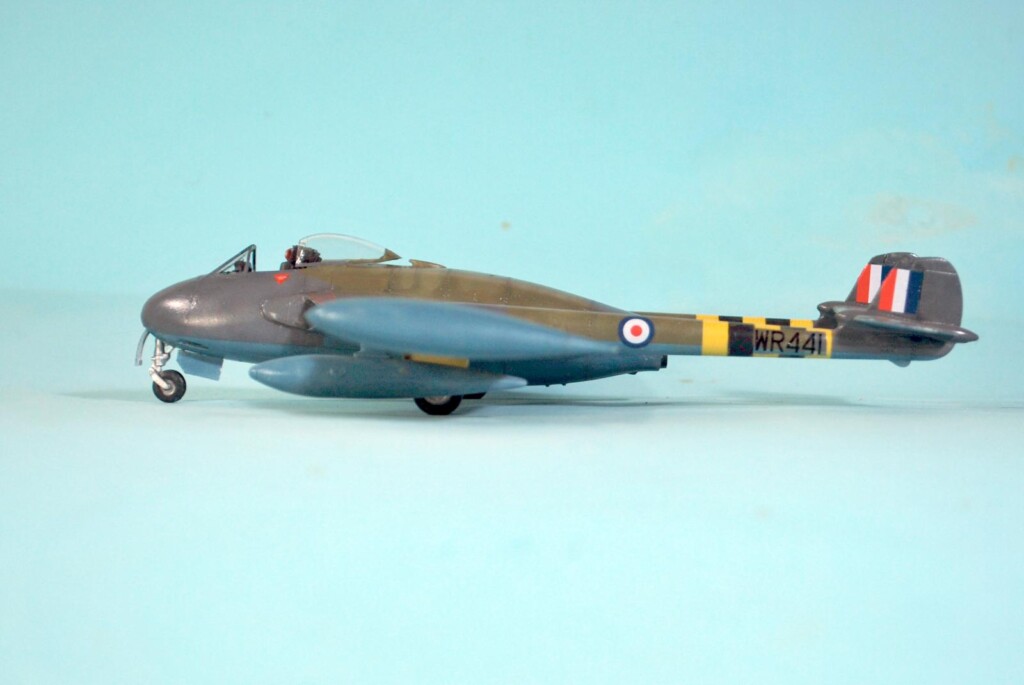
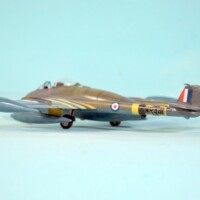
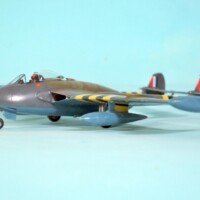
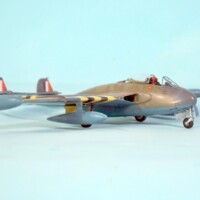
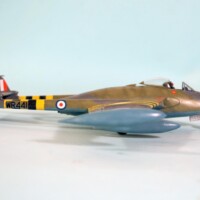
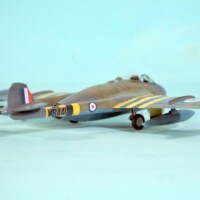
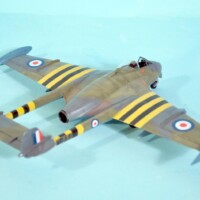
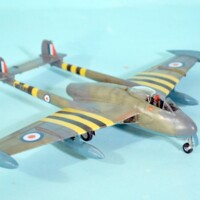
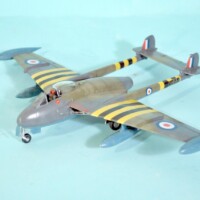
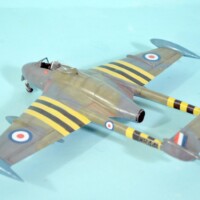
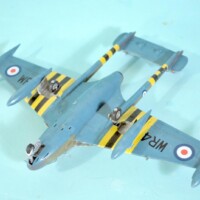

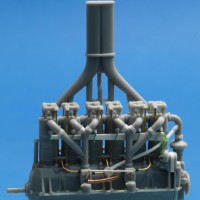
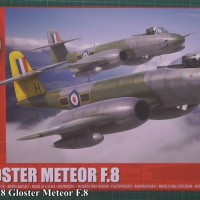
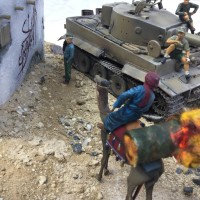
An excellent result, Tom @tcinla
The paintwork and weathering is perfectly done and the identification stripes add a lot.
Thanks for sharing the background of this aircraft.
What @johnb said, Tom!
Build of this challenging kit and article are excellent.
Nicely done, Tom.
Nice work, Tom. The Suez scheme is very striking.
I have always enjoyed the unusual the lines of the Vampire and Venom. Would be nice to see it in 1/32 since we now have the Vampire.
Nice Vemon, Tom!
When I see how small the Vampires and Venoms are, it's surprizing to realize there are 4 cannons hiding under that small cockpit. Quite a punch for a little jet.
Nice work with the camo and the ID striping.
Awesome paintjob, Tom! Love the weathering on the green & grey. Alas, if only Airfix did a 1/72 version of this plane!
Great looking Venom!
Nice addition to the classic British fighter collection, Tom. I really like the colours and all tanks and things sticking out all over.
Please not that the Swedish Venom was the two-seater night fighter version NF.51.
Export version of the night fighter for Sweden with Swedish licence-built engines. Sixty-two - 30 NF.2 and 32 NF.2A - and given the designation J33. It served 1953–1960 at the dedicated night fighter F1 wing at Västerås.
Another great kit, sir!
You mentioned the CA kits. Have you built one and, if so, how do you think it compares to this kit? I've re-read some old reviews I have on file and it seems the Venoms were considerably better fitting than CAs earlier Vampire kits, but, as you say, some modelling skill required!
They're good kits. When I found a Sea Venom FAW21 at Rare Plane Detective for $35 I was immediately on the phone and grabbed it. That kit goes on eBay for $180+.
Well done on a difficult kit, Tom (@tcinla). I have struggled through a few MikroMir kits, and kudos to you for beating this one into submission.
"beating it into submission" - understatement of the year!
Well done, Tom. After a couple of Micro-Mir kits, I got me a bigger hammer. Problem solved!
Hi Tom
Great work - I've built MicroMir kits so I know what you mean. It's an excellent result and a really impressive finish. The history is fascinating.
Christopher
Great work on this to get everything lined up, I've done a few twin boom type aircraft and that part of the construction can be tricky , she looks great.
Interestingly my dad served on RN carriers during the Suez crisis so he may well have seen this particular aircraft in action , small world eh?
That is interesting. He'd very likely have seen the Sea Venoms.
Very nice build, Tom!
Early British jets always look bit cuddly to me for some reason.
The paint work is really good on this Venom.
Nice work, Tom. The Venom is my missing link between my Airfix Vampire and Sea Vixen. Holding out for Pilot Replicas to bring the Sea Venom to market.
Great stuff Tom. Love those colours. Got a Spitfire in waiting
Another great build Tom!
Tom Cleaver (@tcinla)
This one almost slipped under the old radar. It looks good, and from what I have read about these kits, some get started, most get binned, and only a few are completed.
I remember a local man named Harry Doan had one of these British jets, and he flew it on occasion along with his Panther jet. He also had 3 Corsairs, a B-25, and a basket case SBD that looked like a pile of scrap metal. It was interesting to see it flying in the air, especially when the tail booms looked so thin.
I'm not sure exactly if he had a Vampire or a Venom now. I do know that it was a twin boom early British jet, and I just might have a picture or two of it in the sky.
As usual, I enjoyed reading the article. Well done !